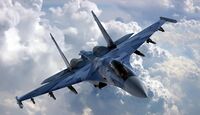Sukhoi Su-35
The Sukhoi Su-35 (Russian: Сухой Су-35, NATO reporting name: Flanker-E) is a single-seat, twin-engine supermaneuverable multirole fighter. It is a derivative of the Su-27 'Flanker', and was initially known as the Su-27M. More than a dozen of these were built with some used by the Russian Knights aerobatic demonstration team. The Su-35 had been offered to many countries, including Brazil, China, Egypt, India, Indonesia, Iraq, Libya, South Korea, and Venezuela.
In the 1980s, Sukhoi was looking to upgrade its high-performance Su-27. The resultant Su-35 embodies aerodynamic refinements to give it more maneuverability, greatly enhanced avionics, longer range, and a more powerful engine. The first prototype, converted from a production Su-27, made its maiden flight in June 1988. The Su-35 was further developed into the Su-37, which has thrust-vectoring capabilities, and the Su-35BM, classified as 4++ generation fighter by its manufacturer. The new model entered into serial production as the Su-35S for the Russian Air Force in 2010.
Variants[edit | edit source]
- Su-27M/Su-35: Single-seat fighter design with a factory code of T-10M (Modernizerovany, "Upgraded"). The first two prototypes had a new forward fuselage, canards and updated fly-by-wire flight-control systems. Like three of KNAAPO's nine flying pre-production aircraft (T10M-5, T10M-6 and T10M-7), they were converted from Su-27 airframes. The third aircraft (T10M-3) was the first of seven pre-production aircraft to have the taller vertical tails, two-wheel nose undercarriage and in-flight refuel capability. The Su-27M was powered by AL-31FM turbofan engines. Two prototypes, nine pre-production and three production aircraft were constructed by 1995; two static-test aircraft was also constructed (T10M-0 and T10M-4). The aircraft did not enter mass production.
- Su-37: Technology demonstrator, converted from the eleventh developmental Su-27M (T10M-11). The Su-37 featured a digital fly-by-wire flight-control system, a glass cockpit, the N011M radar, and AL-31FP engines with thrust-vectoring nozzles. The aircraft was later fitted with standard-production AL-31F engines, and had its flight-control system and cockpit systems revised.
- Su-35UB: Two-seat trainer designed and built by KnAAPO. The single aircraft (T-10UBM-1) featured the canards and taller vertical tails of the Su-27M and a forward fuselage similar to the Su-30MKK. The Su-35UB also shared the avionics suite of the Su-30MKK, although it had a different fly-by-wire flight-control system to accommodate the canards. The aircraft was powered by AL-31FP engines with thrust-vectoring nozzles. Although a training aircraft, the Su-35UB was designed to be fully combat-capable.
- Su-35BM: Single-seat fighter that is a major redesign of the original Su-27. The type features significant modifications to the airframe, including the removal of canards and dorsal air brake as found on the Su-27M. It features the updated N035 Irbis-E radar and a redesigned cockpit. The aircraft is powered by thrust-vectoring AL-41F1S turbofan engines that are capable of supercruise. Also known as T-10BM (Bolshaya Modernizatsiya, "Major Modernization"), Su-35BM is not the actual designation used by Sukhoi, who markets the aircraft as "Su-35".
- Su-35S: Designation of production T-10BM design for the Russian Air Force. According to Aviation Week & Space Technology, "S" stands for Stroyevoy ("Combatant").
Users[edit | edit source]
- Algeria
- Algerian Air Force
- People's Republic of China
- People's Liberation Army Air Force
- Egypt
- Egyptian Air Force
- Iraq
- Iraqi Air Force
- Libya
- Libyan Air Force
- Russia
- Russian Air Force
- Russian Naval Aviation
- Venezuela
- Venezuelan Air Force

